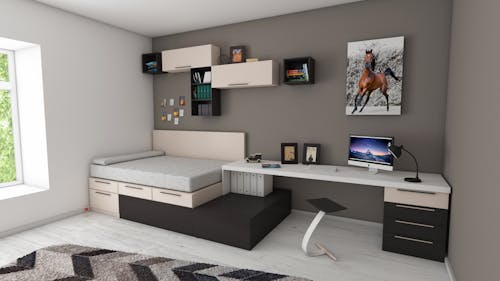“Small Space Solutions: Creating a Beautiful Minimalist Living Room
Living in a small space can feel challenging, but it also presents unique opportunities for creativity. One of the most effective ways to make a small room feel larger and more serene is by embracing minimalism. Creating a **minimalist living room** isn’t just about having less; it’s about having *the right* things and arranging them thoughtfully. This guide will show you how to transform your small living area into a tranquil, functional, and beautiful minimalist retreat.
Why Choose a Minimalist Living Room for Your Small Space?
Opting for a **minimalist living room** in a confined area offers significant advantages. Reducing visual clutter immediately makes the space feel more open and spacious. It simplifies cleaning and maintenance, and fosters a sense of calm and tranquility. Furthermore, a minimalist approach allows the carefully chosen items in your room to truly shine.
The Essential First Step: Decluttering
The cornerstone of any **minimalist living room** is decluttering. Be prepared to be ruthless. Go through every item in your living space – books, decor, electronics, cushions. Ask yourself: Is this item truly necessary? Does it add value or beauty? Does it serve a purpose? Be honest. Donate, sell, or discard anything that doesn’t meet the criteria. A clutter-free foundation is non-negotiable for achieving a minimalist aesthetic.
Choose Furniture Wisely: Scale and Function
In a small **minimalist living room**, every piece of furniture must earn its place. Avoid bulky or oversized items that dominate the room. Look for multi-functional furniture like ottomans with hidden storage, sofa beds, or nesting tables. Choose pieces that are proportionate to the room’s scale. Furniture with visible legs or transparent elements (like a glass coffee table) can create a sense of openness.
Keep it Simple: The Power of Color
The color scheme in a small **minimalist living room** should contribute to its airy feel. Stick to a simple, neutral palette of whites, creams, grays, and soft beiges. These colors reflect light and make the space feel larger and brighter. You can introduce limited pops of color through textiles or art, but avoid overwhelming the room with too many different hues. A monochromatic or limited-color scheme reinforces the minimalist aesthetic.
Brighten Up: Maximizing Light
Lighting is crucial for making any small space feel inviting. Maximize natural light by keeping windows clear and using sheer or minimal window treatments. Supplement with artificial lighting – a mix of overhead, floor, and table lamps can create layers of light, adding depth and warmth to your **minimalist living room**. Proper lighting prevents a small space from feeling dim and cramped.
Smart Storage is Key
Maintaining a **minimalist living room** requires smart organization. Ensure every item has a designated place to prevent clutter from creeping back in. Utilize hidden storage solutions like stylish baskets, lidded containers, or furniture with built-in storage. Vertical storage, such as floating shelves, draws the eye upwards and keeps floor space clear. The goal is to keep surfaces as uncluttered as possible.
Intentional Decor, Not Clutter
A **minimalist living room** doesn’t mean a sterile one. It means being intentional with your decor. Select a few cherished art pieces, a calming plant, or a high-quality throw pillow. Each item should add beauty or meaning without contributing to visual noise. Avoid excessive small knick-knacks or collections that can quickly make a small space feel cluttered again.
Conclusion
Creating a **minimalist living room** in a small space is a process of thoughtful choices and intentional living. By decluttering, selecting furniture wisely, simplifying your palette, maximizing light, organizing smartly, and choosing decor with purpose, you can transform a cramped area into a peaceful, functional, and aesthetically pleasing retreat. Embrace the beauty of less and enjoy the calm your new space brings.”




